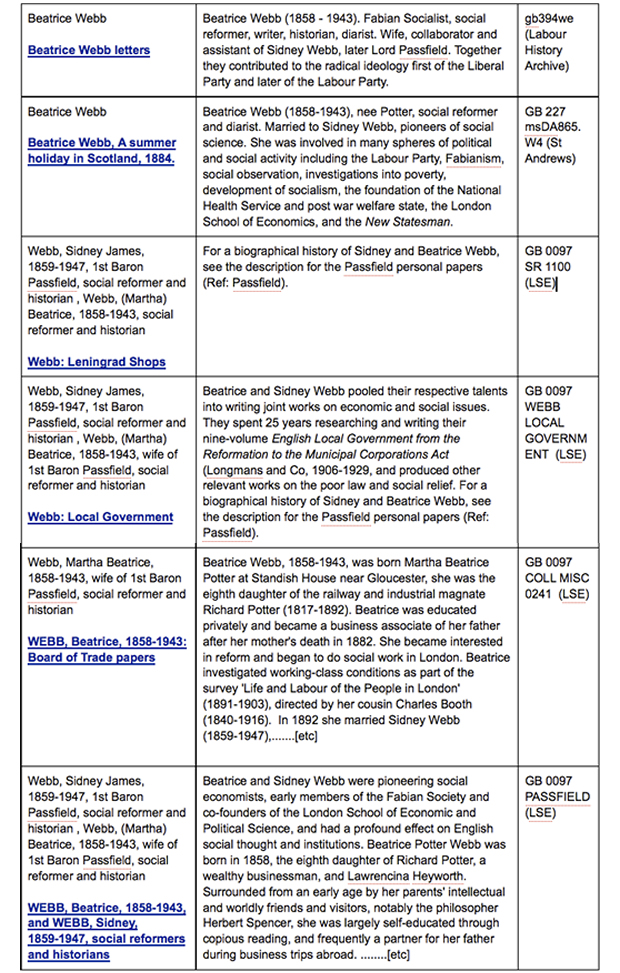We are currently evaluating ICA-AtoM, and it is throwing up some really useful ideas and some quite difficult issues because it supports the creation of name authorities, and it also automatically creates authority records for any creator name and any names within the access points when you upload an archive description.
As far as I am concerned, the idea of name authorities is to create a biographical entry for a person or organisation, something that gives the researcher useful information about the entity, different names they use, significant events in their life, people they know, etc (all set out within the ISAAR(CPF) standard (PDF)). You can then link to the archive collections that relate to them, thus giving the archives more context. You can distinguish between archives that they ‘created’ (were responsible for writing or accumulating), and archives that they are a subject of (where they are referenced – maybe as an access point in the index terms).
The ideal vision is for one name authority record for an entity, and that authority record intellectually brings together the archives relating to the entity, which is a great advantage for researchers. However, this is not practically achievable. Just the creation and effective use of name authorities to bring archives together at any level is quite challenging. For the Hub we have a number of issues….
Often we have more than one archive collection for the same entity (let’s say person, although it could be a corporate body or family). I’ll take Martha Beatrice Webb as an example, because we have 9 collections on the Archives Hub where she is a creator. She’s also topical, as the LSE have just launched a new Digital Library with the Beatrice Webb diaries!
There is nothing wrong with any of these entries. In fact, I pick Beatrice Webb as an example because we do have some really good, detailed biographical history entries for her – exactly what we want in a collection description, so that researcher can get as much useful information as possible. We have always recommended to our contributors that they do provide a biographical history (we know from researchers that this is often useful to them; although conversely it is true to say that some researchers see it as unnecessary).
We have nine collections for Beatrice Webb, and three repositories holding these collections.
If we were to try to create one authority record for these nine collections:
1. Which biographical history would we use? Would we use them all, which means a lot of information and quite a bit of duplication? Would we pick the longest one? What criteria could we use?
2. Two of these collections are attributed to Beatrice and Sydney Webb. Ideally, we would want to link the collections to two authority records – one for Beatrice and one for Sydney, but the biographical history is for both of them, so we would probably end up with an authority record for ‘Beatrice and Sydney Webb’ as an entity.
3. The name of creator is entered differently in the descriptions – ‘Beatrice Webb’ and ‘Webb, Martha Beatrice, 1858-1943, wife of 1st Baron Passfield, social reformer and historian’. This is very typical for the Hub. Sometimes the name of creator is entered simply as forename and surname, but sometimes the same elements as are used for the index term entry are used – sometimes in the same (inverted) order and sometimes not. This makes it harder to automatically create one authority record, because you have to find ways to match the names and confirm they are the same person.
4. Maybe it would be easier to try to create one authority record per repository, so for Beatrice Webb we would have three records, but this would go against the idea of using name authorities to help intellectually bring archives together and still leaves us with some of the same challenges.
5. How would we deal with new descriptions? Could we get contributors to link to the authority records that have been created? Would we ask them to stop creating biographical histories within descriptions?
6. The name as an access point is often even more variable than the name as creator, although it does tend to have more structure. How can we tell that ‘Martha Beatrice Webb’ is the same person as ‘Beatrice Webb’ is the same person as ‘Beatrice Potter Webb’? For this we’ll have to carry out analysis of the data and pattern matching. For some names this isn’t so difficult, such as for Clough Williams-Ellis and Clough Williams Ellis. But what about ‘Edward Coles’ (author of commonplace book c. 1730-40) and ‘Edward Coles fl. 1741’? With archives, there is a good deal of ‘fl’ and ‘c’ due to the relative obscurity of many people within archive collections. If we don’t identify matches, then we will have an authority record for every variation in a name.
7. We will have issues where a biographical history is cross-referenced, as in one example here. It makes perfect sense within the current context, and indeed, it follows the principle of using one biographical history for the same person, but it requires a distinct solution when introducing authority records.
I would be really interested to know what archivists, especially Hub contributors, think about linking to authority files. I am very excited about the potential, and I believe there is so much great information tied up in biographical and administrative history fields that would help to make really useful authority records, but the challenges are pretty substantial. Some questions to consider:
(1) Would you be happy to link to a ‘definitive’ authority record? What would ‘authority’ and ‘definitive’ mean for you?
(2) Would you like to be able to edit the ‘definitive’ record – maybe you have further information to add to it? Would this type of collective authorship work?
(3) Would you rather have one authority record for each repository?
(4) Would you rather have room within an archive description to create a biographical entry that reflected that particular archive?
(5) Would you like to see co-ordination of the creation and use of name authorities? Maybe it’s something The National Archives could lead, following their work in maintaining names through the National Register of Archvies?
I’m sure you can think of other questions to ask, and maybe you have some questions to ask of us about our review? Suffice to say that we have no plans to change our software – this is currently just an assessment, but we are seriously thinking of how we can start to incorporate name authorities into the Archives Hub.
Finally, its worth mentioning that if you are interested in ways to bring biographical histories together, you might like to follow our ‘Linking Lives’ linked data project through the Linking Lives blog, as for this project we are looking at providing an interface that gives then end user something a little like a name authority record, only it will include more external links to other content.






